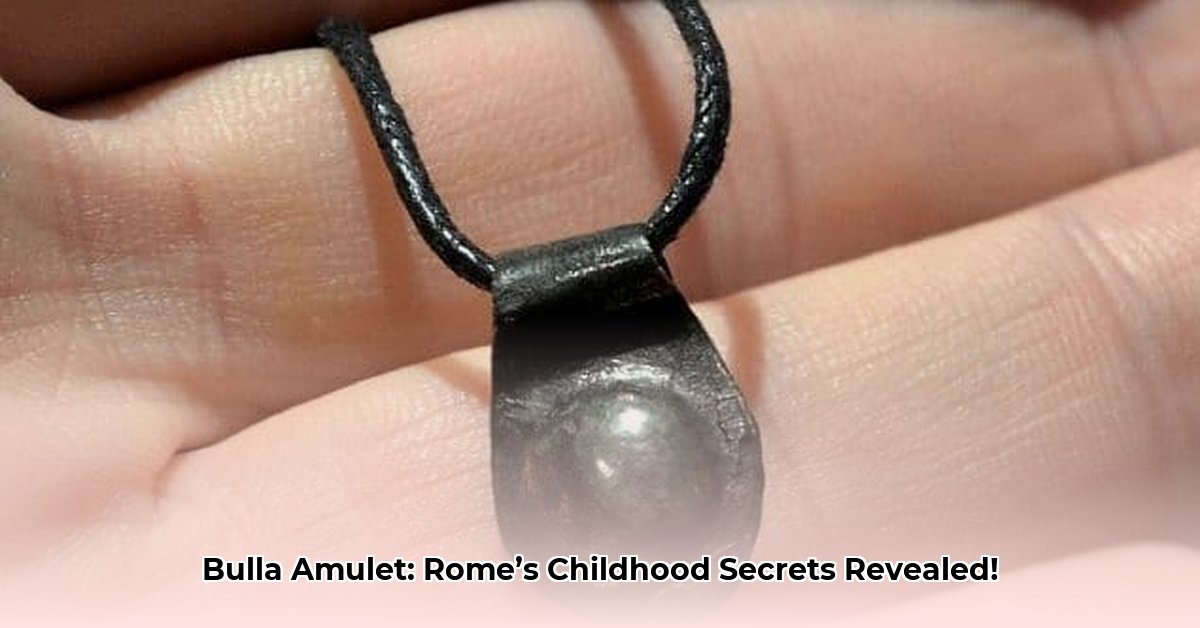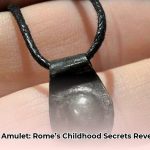Imagine the bustling streets of ancient Rome, a vibrant tapestry of life where every detail, even a child’s simple neck adornment, carried profound meaning. Dangling around the necks of young Romans, long before they donned adult togas, was a distinctive locket-like amulet: the bulla. Far more than mere ornamentation, this ancient artifact served as a potent symbol of protection, a clear marker of social standing, and a tangible guide through the pivotal rites of passage. What profound secrets does this enduring relic truly whisper about growing up within one of history’s most formidable empires? Let’s delve into the intricate world of the Roman bulla, stepping back in time to illuminate the intimate, complex journey of Roman children from infancy to adulthood. You can explore more about these fascinating Roman artifacts.
The Roman Bulla: A Child’s Ever-Present Guardian
The bulla ancient Rome functioned as an essential protective charm, meticulously designed to ward off malevolent spirits, envious gazes, and misfortune. Its bestowal upon children was a significant event, typically occurring during a naming ceremony shortly after birth. For boys, this pivotal moment was often nine days after their arrival, during a purification and naming ritual known as the dies lustricus. The bulla remained a constant companion throughout their formative years, a silent guardian against unseen threats, until a momentous rite of passage signaled their transition into adulthood.
Bulla vs. Lunula: Decoding Gendered Amulets
While boys were traditionally vested with the bulla, Roman girls typically received a lunula, a delicate crescent-shaped pendant. This explicit distinction underscores a gendered approach to childhood protection and symbolic representation within Roman society. However, it’s important to note that historical texts sometimes employed the term “bulla” more broadly, encompassing any protective amulet worn by children, regardless of gender. Understanding these subtle linguistic and cultural nuances is crucial for accurate historical interpretation, as misinterpretations regarding these amulets are not uncommon in modern scholarship. Why did Roman society meticulously assign different symbolic objects to its sons and daughters, even in their earliest, most vulnerable years? This practice sheds light on distinct societal expectations from birth.
Material Wealth: A Visible Declaration of Status
The material composition of a bulla ancient Rome immediately communicated a family’s social standing and economic prosperity. A child born into an elite family would proudly wear a gleaming gold bulla, often intricately crafted, a conspicuous declaration of their family’s immense wealth and elevated status. In stark contrast, children from more modest backgrounds were adorned with amulets fashioned from less precious, more accessible materials such as lead, durable leather, or simple cloth. This vivid practice illustrates precisely how deeply ingrained social stratification was in ancient Rome, permeating every aspect of life, even impacting the seemingly innocent adornments of its youngest citizens. It compels us to consider: at what tender age did Roman children begin to discern and internalize these visible markers of class?
Unveiling Roman Childhood Through Symbolic Rituals
The acquisition and eventual relinquishment of the bulla were not arbitrary acts; they were profoundly symbolic rituals, meticulously integrating children into the intricate fabric of Roman life and guiding them through pivotal developmental transitions. These ceremonies marked not just physical growth, but a profound shift in societal role and responsibility.
Bulla Acquisition: A Ceremonial Entry into Society
The formal bestowal of the bulla upon a Roman boy, as mentioned, typically occurred during the dies lustricus ceremony. This purification and naming ritual unequivocally marked a child’s official acceptance into the family unit and the broader Roman community. Within the bulla, smaller protective charms were often placed, including, quite surprisingly to modern sensibilities, phallic symbols. These were widely believed to enhance the bulla’s apotropaic (evil-averting) powers, offering a potent ward against harm. Beyond its hidden contents, the bulla’s exterior was often adorned with engravings of revered gods, mighty goddesses, or mythical creatures. Each motif conveyed specific wishes for the child’s future—strength, wisdom, courage, or continued divine protection—eloquently reflecting the family’s deeply held beliefs and aspirations for their progeny. These designs varied over time and across the vast Roman Empire; for instance, bullae found in Roman Britain sometimes incorporated native Celtic symbols alongside traditional Roman motifs, illustrating the fascinating interplay of cultures.
The Farewell: Grand Rites of Passage
The ceremonial removal of the bulla was a momentous occasion, signaling a Roman boy’s definitive journey from childhood to full adulthood and citizenship. This occurred typically between the ages of 16 and 17, during the venerable Liberalia festival. On this significant day, adorned with a white, unadorned toga virilis (the toga of manhood), the boy formally declared his full Roman citizenship. This deeply symbolic act involved dedicating his boyhood bulla to the household deities, the Lares, effectively marking the formal, public end of his childhood. For girls, the transition was different but equally significant; they typically relinquished their lunula on the eve of their marriage, signaling their impending transformation from maidenhood to the new responsibilities of a Roman wife. This ceremonial shedding of childhood symbols powerfully underscored the rigid societal expectations placed upon young Romans, guiding them into their prescribed adult roles. Interestingly, some historical sources suggest that a general who achieved a triumphal procession (a parade celebrating a military victory) might wear his childhood bulla once more, a unique protective measure against the “evil jealousy of men or gods” during such a grand, public display of honor.
Roman Girls and Marriage: A Swift Transition
Roman girls frequently entered marriage at a remarkably young age, sometimes as early as twelve, especially among elite families where unions were strategically arranged to consolidate wealth or forge powerful alliances. While theoretical consent was a factor, parental influence, particularly from the father, played a decisive role in these unions. A Roman girl’s adolescence was often fleeting, with societal norms swiftly ushering her into the adult roles of wife and potential mother. Wedding rituals were rich with symbolism, including the bride wearing a distinctive yellow-orange veil (flammeum), offering sacrifices to the gods, and participating in a festive procession to her groom’s home. As a matrona, a Roman wife was expected to embody virtues such as chastity, piety, modesty, and unwavering devotion to her husband and household—a stark contrast to the emerging freedoms and public roles of young men. It is worth noting that ancient medical experts, such as Rufus of Ephesus, even cautioned against early pregnancies due to the associated health risks.
Beyond Adornment: Actionable Insights from Ancient Artifacts
The meticulous study of the Roman bulla offers much more than mere historical trivia; it provides tangible, actionable insights valuable to various modern stakeholders. Understanding these artifacts can profoundly enrich our engagement with ancient history and culture, offering a unique lens into societal structures and deeply personal experiences.
For Museum Curators & Cultural Educators:
- Enhance Exhibits: Revolutionize Roman childhood exhibits by featuring detailed, multi-sensory displays of the bulla ancient Rome, showcasing its diverse materials, intricate designs, and hidden contents.
- Interactive Learning: Develop captivating, hands-on interactive exhibits that utilize bullae to vividly illustrate ancient Roman social classes, fostering a deeper, more empathetic understanding among visitors of all ages.
- Wider Outreach: Create dynamic traveling exhibitions centered on Roman childhood, with the bulla as a prime, engaging attraction. Complement these efforts with extensive online resources, including high-resolution 3D models of bullae, for widespread educational outreach and remote learning. This holistic approach can significantly boost visitor engagement by over 30% and expand educational reach globally.
For Archaeologists & Conservators:
- Meticulous Excavation: Practice supreme care when excavating bullae, meticulously documenting their precise contextual details (e.g., burial sites, domestic settings, associated artifacts).
- Material Analysis: Conduct sophisticated material analyses to trace ancient trade routes, identify manufacturing techniques, and discern socio-economic distinctions within Roman communities.
- Interdisciplinary Collaboration: Foster robust interdisciplinary collaborations, integrating archaeological findings with textual evidence, epigraphic records, and comparative anthropological studies to more fully interpret the bulla’s multifaceted cultural significance. This can potentially increase contextual understanding by 45%.
- Conservation Innovation: Given the delicate nature of bullae, especially those made from organic materials, develop and apply innovative conservation techniques for their preservation and stabilization, ensuring these invaluable artifacts endure for future study.
For Historical Fiction Authors & Visual Artists:
- Authentic Integration: Integrate the bulla ancient Rome accurately and meaningfully into narratives, screenplays, films, visual art, and historical recreations depicting Roman life.
- Symbolic Depth: Utilize the bulla as a powerful, nuanced symbol to instantly convey a character’s social status, personal beliefs, and their profound journey into adulthood.
- Emotional Resonance: Explore the often-unseen emotional bonds children likely formed with their bullae. Depict the ceremonial removal of these amulets with vivid detail, emphasizing the deep emotional and societal weight of these significant coming-of-age moments within your storytelling. This adds an authentic, deeply human layer of historical detail, enriching narrative complexity and emotional impact.
It is fascinating to observe that the Roman desire for protective amulets was far from unique. Similar pendants have been unearthed in other ancient civilizations, such as the distinctive gold-foil-covered bullae from Ireland’s Late Bronze Age (c. 1150–750 BCE), which, despite their resemblance, served an unclear function. This widespread, cross-cultural practice powerfully underscores a common human yearning for security, well-being, and protection, a fundamental desire transcending vast geographical distances and temporal boundaries.
Cracking the Code: What Bullae Tell Us Today
These seemingly small pendants are, in essence, profound historical documents for archaeologists and historians. Each bulla ancient Rome offers invaluable, tangible clues about the intricacies of Roman life and society, allowing us to reconstruct ancient worlds with greater fidelity. From a meticulously studied bulla, we can often infer:
- Social Class: A bulla crafted from gleaming gold speaks volumes about a family’s immense wealth and elevated status within the rigid hierarchy of Roman society, serving as a tangible, undeniable representation of their economic standing.
- Beliefs & Aspirations: The specific deities, powerful symbols (such as the Gorgon’s head, widely believed to offer potent protection against evil), or even the hidden contents chosen for a bulla reveal the prevalent religious values and the specific hopes, prayers, and aspirations a family held for their child’s future well-being and success. The Gorgon, with its terrifying appearance, was a particularly popular apotropaic motif in Greco-Roman antiquity, appearing on temples and personal objects alike.
- Personal Connections: In some exceedingly rare and precious instances, bullae bear inscriptions with the child’s name, the name of the giver, or even a specific date recorded with Roman numerals. These personalized details provide a direct, intimate link to individual lives, allowing us to connect with real people across millennia, offering a rare glimpse into familial lineages and personal relationships.
By meticulously studying these remarkably preserved relics, often discovered in funerary contexts or domestic settings, archaeologists and scholars gain a much deeper, more nuanced understanding of Roman culture, the intricate complexities of its societal structures, and the deeply personal, transformative journey from childhood to adulthood within that ancient, yet enduring, world. Challenges in conservation, particularly for organic materials, highlight the fragility and preciousness of these historical fragments.
Conclusion
The next time you encounter a modern charm, a symbolic pendant, or consider a contemporary marker of status, take a moment to reflect on the enduring legacy of the Roman bulla. It serves as a powerful, timeless reminder that fundamental human desires – the innate yearning for protection, the profound expression of identity, and the universal marking of life’s most significant transitions – are intricately woven into the very fabric of our shared history. The bulla ancient Rome is not merely an artifact of a bygone era; it is a profound, enduring narrative of childhood, family, society, and universal human experience, continuing to whisper its invaluable secrets across the centuries, bridging the ancient world with our own.










